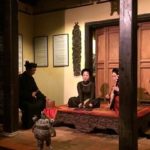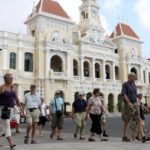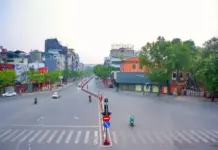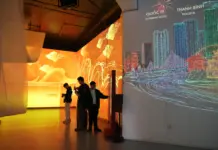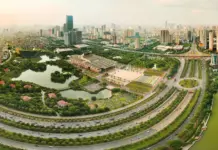Building an interactive on-site museum of Thang Long Citadel relics is among the ideas raised by French experts to highlight the cultural significance and promote the value of the archaeological site in Hanoi.
The ideas presented at the seminar “Promoting the Value of Thang Long Imperial Citadel Archaeological Site” held at the 12th Vietnam-France Decentralized Cooperation Conference on April 14-16 were highly acclaimed. The gathering saw a great exchange of views on how to best promote the importance of this site and its cultural significance. Participants discussed potential strategies to raise awareness of the site, such as educational tours and public outreach programs. In addition, participants also discussed ways to conserve and protect the site’s archaeological artifacts. Overall, the seminar provided a platform for learning about the cultural heritage of Thang Long Imperial Citadel.
With many layers of culture and history, the Thang Long Imperial Citadel is not only a symbol of Vietnam’s rich feudal past, but also an intriguing destination for international tourists. Despite its undeniable allure, the heritage site located in the heart of Hanoi is facing difficulties in promoting its cultural significance due to a number of factors.
Vietnamese and French experts discussed solutions to tackle the problems posed by protecting excavation pits at heritage sites in urban areas, with architect Jean François Milou suggesting the construction of an on-site museum as a popular solution employed around the world.
“The strict planning requirements of the area around the Thang Long Imperial Citadel mandate that new buildings must not exceed 5 meters in height,” Milou declared.
| Vietnamese and French experts talk about the preservation of Thang Long Imperial Citadel. Photo: Ngo Minh/The Hanoi Times |
This park could be transformed into a stunning oasis dedicated to the historical remains of the Thang Long Imperial Citadel. From the side of the parliament building, visitors would be able to admire the majestic sight of two buildings standing in perfect harmony, representing the intertwined past and present of Hanoi. Inside the park, a large underground archaeological museum would be accessible, granting guests the opportunity to explore the excavation pits up close.
Architect Maie Kitamura, a French expert in heritage conservation, agreed with the idea that the Thang Long Citadel’s Relics Management Board must consider a plan to protect the relics and artifacts in inclement weather. She suggested that the board should restore the old drainage system to manage rainwater and groundwater surges, promote the values of the site, and strengthen heritage education. In this way, they can ensure that the Thang Long Citadel’s invaluable artifacts and relics are safeguarded for future generations.
Pierre Pisani, the Director of Heritage for Toulouse City Hall, recently announced that the archaeological site of La domus de Cieutat in Eauze bears striking similarities to the Thang Long Imperial Citadel. This area encompasses three distinct sites which all complement one another; the Eauze Ruins, Eauze Museum, and Montréal Ruins. Visitors to the area can explore each of these locations and gain a better understanding of the history and culture of the region.
As soon as excavations began in 2001, the town of Eauze and the authorities had a plan to exploit and promote the value of the area. To this end, in 2009, the city launched a project management contest and selected the winning team while the excavations were still underway. Finally, in 2013, the archaeological site was opened to the public, allowing visitors to explore its wonders.
|
An intriguing artifact unearthed from the Thang Long Imperial Citadel relics has caught the attention of historians and archaeologists alike. Discovered by a team of researchers from the Hanoi-based Institute of Archaeology, the artifact is believed to have been used during the era of the ancient citadel. Photo: Ngo Minh/The Hanoi Times With its intricate design and unique features, the artifact has been hailed as a significant discovery that could potentially shed light on the lifestyle and culture of the people who lived during the time of the ancient citadel. It is also thought to provide clues to the history and evolution of the Thang Long Imperial Citadel. |
In the process of exploitation, the heritage site aims to achieve three main objectives: protecting and promoting the value of archaeological relics by constructing a roof system; exhibiting relics from the 4th century; and restoring the underground water system.
Pisani proposed that the historical relics of Thang Long Citadel could be promoted and presented to visitors in a style similar to that of La domus de Cieutat in Eauze. By doing so, visitors would be able to experience and appreciate the cultural heritage of the site, as well as gain a better understanding of its significance.
“To be successful in preserving and protecting heritage values,” he said, “the project requires the collaboration of archaeologists, architects, authorities, and various organizations.”
Director of the Thang Long-Hanoi Heritage Conservation Center, Nguyen Thanh Quang, highly praised the ideas of the French experts, as the results of the seminar would serve as a scientific foundation for the center to create plans to protect and enhance the value of archaeological heritage.
“Preserving and promoting the value of archaeological heritage, particularly in urban areas, is a challenging issue faced by many countries, not just Vietnam,” Quang said. “The difficult question is how to reconcile the presence of archaeological remains and their priceless artifacts with the march of urbanization.”
Ancient house in Ma May
NDO – Ma May, a rare quarter that still retains several old houses, has created one of the characteristics of Hanoi. Hanoi’s streets are becoming increasingly crowded and traditional features can sometimes be hidden behind modern life. But if one takes the time to relax and look around, the ancient features begin to reveal themselves.





